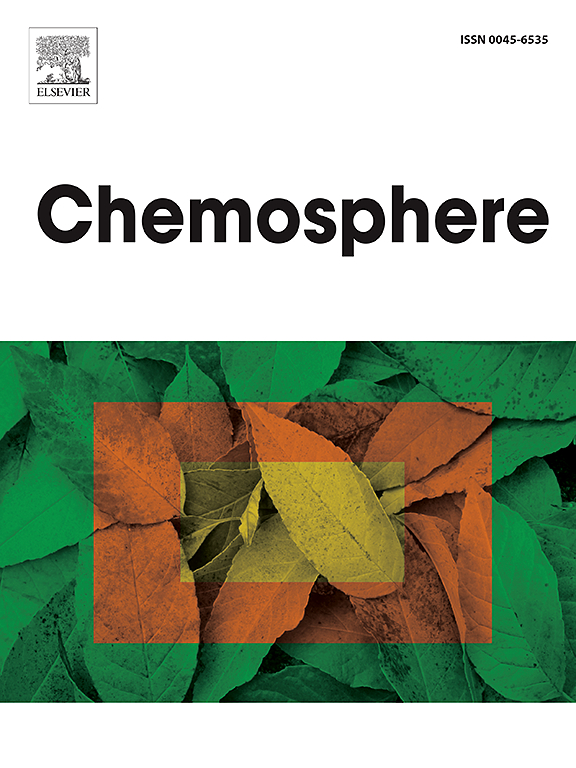评价嗜粘阿克曼氏菌和prausnitzi粪杆菌对双酚F和四甲基双酚F的体外去除效果
IF 8.1
2区 环境科学与生态学
Q1 ENVIRONMENTAL SCIENCES
引用次数: 0
摘要
我们进行了开创性的研究,评估了嗜muciniphila和Faecalibacterium prausnitzii作为下一代益生菌(NGPs)去除双酚A (BPA)类似物,如双酚F (BPF)和四甲基双酚F (TMBPF)。通过受污染的食物长期接触这些尚未得到充分研究的化合物,会促进肠道微生物群失衡和炎症,从而对健康构成风险。在我们的实验中,经过巴氏灭菌的F. prausnitzii在48小时后去除高达87%的TMBPF(从9,976±0,790 μg/mL到1,350±0,330 μg/mL), p <;0.0001)。同时,A. muciniphila对BPF的去除率达到48%(从10,33±0,96 μg/mL降至5,33±0,62 μg/mL, p <;0.0001)。不同条件下的生物吸附和生物转化机制比较,差异显著(p <;0.01), 48 h后仅在嗜粘杆菌和嗜粘杆菌中观察到。尽管嗜粘杆菌发酵后的上清液使细胞活力降低至68%,但在Caco-2细胞中未观察到原料双酚的细胞毒性作用(p <;0.001)。值得注意的是,TMBPF没有雌激素活性,而BPF具有较强的雌激素活性,在两种菌株孵育后均下降。这些发现证实,这两种ngp都能降低双酚浓度,支持它们在解毒和功能性食品开发中的应用。在食品生产和补充中实施基于ngp的战略可以降低人类对有害双酚类物质的暴露。这种方法强调了先进益生菌在减轻食源性化学品风险方面的前景,并与不断发展的法规和保护消费者的公共卫生努力保持一致。本文章由计算机程序翻译,如有差异,请以英文原文为准。

Evaluating the in vitro removal of bisphenol F and tetramethyl bisphenol F by Akkermansia muciniphila and Faecalibacterium prausnitzii
We conducted pioneering research evaluating Akkermansia muciniphila and Faecalibacterium prausnitzii as next-generation probiotics (NGPs) for removing bisphenol A (BPA) analogues, such as bisphenol F (BPF) and tetramethylbisphenol F (TMBPF). Chronic exposure to these under-researched compounds through contaminated food poses a risk to health by promoting gut microbiota imbalances and inflammation. In our experiments, pasteurized F. prausnitzii removed up to ∼87 % of TMBPF after 48 h (from 9,976 ± 0,790 μg/mL to 1,350 ± 0,330 μg/mL μg/mL, p < 0.0001) through bioadsorption. Meanwhile, A. muciniphila achieved ∼48 % removal of BPF (from 10,33 ± 0,96 μg/mL to 5,33 ± 0,62 μg/mL, p < 0.0001) via biotransformation also after 48 h. Bioadsorption and biotransformation mechanisms were compared across conditions, with significant differences (p < 0.01) observed only for A. muciniphila with BPF and F. prausnitzii with TMBPF after 48 h. No cytotoxic effects of raw bisphenols were seen in Caco-2 cells, although the post-fermentation supernatant from A. muciniphila reduced cell viability to 68 % (p < 0.001). Notably, TMBPF showed no estrogenic activity, while BPF exhibited strong estrogenicity, which decreased following incubation with both strains. These findings confirm both NGPs reduce bisphenol concentrations, supporting their use in detoxification and functional food development. Implementing NGP-based strategies in food production and supplementation could lower human exposure to harmful bisphenols. This approach underscores the promise of advanced probiotics in mitigating foodborne chemical risks and aligns with evolving regulations and public health efforts to protect consumers.
求助全文
通过发布文献求助,成功后即可免费获取论文全文。
去求助
来源期刊

Chemosphere
环境科学-环境科学
CiteScore
15.80
自引率
8.00%
发文量
4975
审稿时长
3.4 months
期刊介绍:
Chemosphere, being an international multidisciplinary journal, is dedicated to publishing original communications and review articles on chemicals in the environment. The scope covers a wide range of topics, including the identification, quantification, behavior, fate, toxicology, treatment, and remediation of chemicals in the bio-, hydro-, litho-, and atmosphere, ensuring the broad dissemination of research in this field.
 求助内容:
求助内容: 应助结果提醒方式:
应助结果提醒方式:


